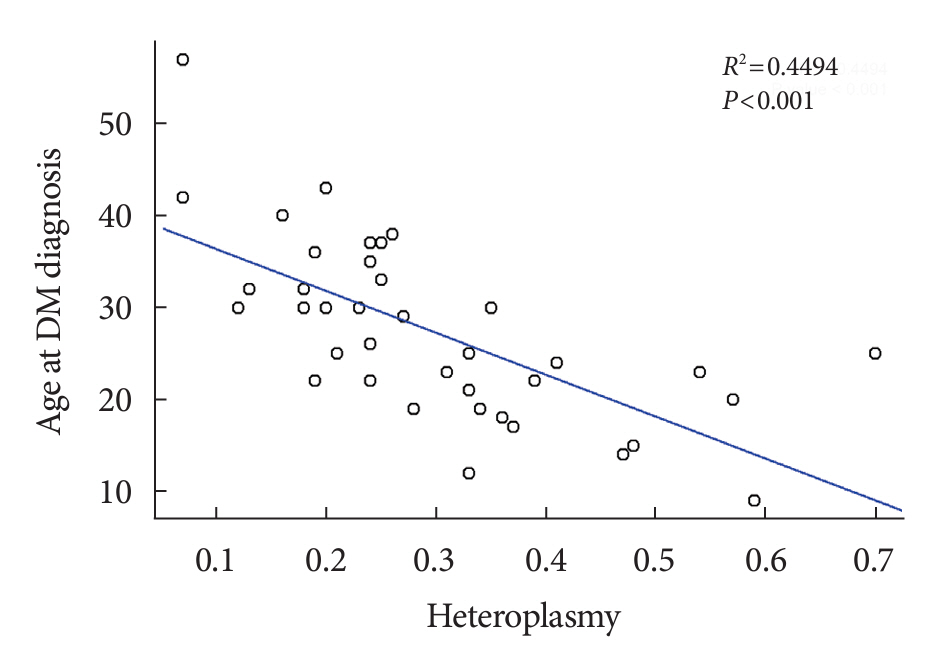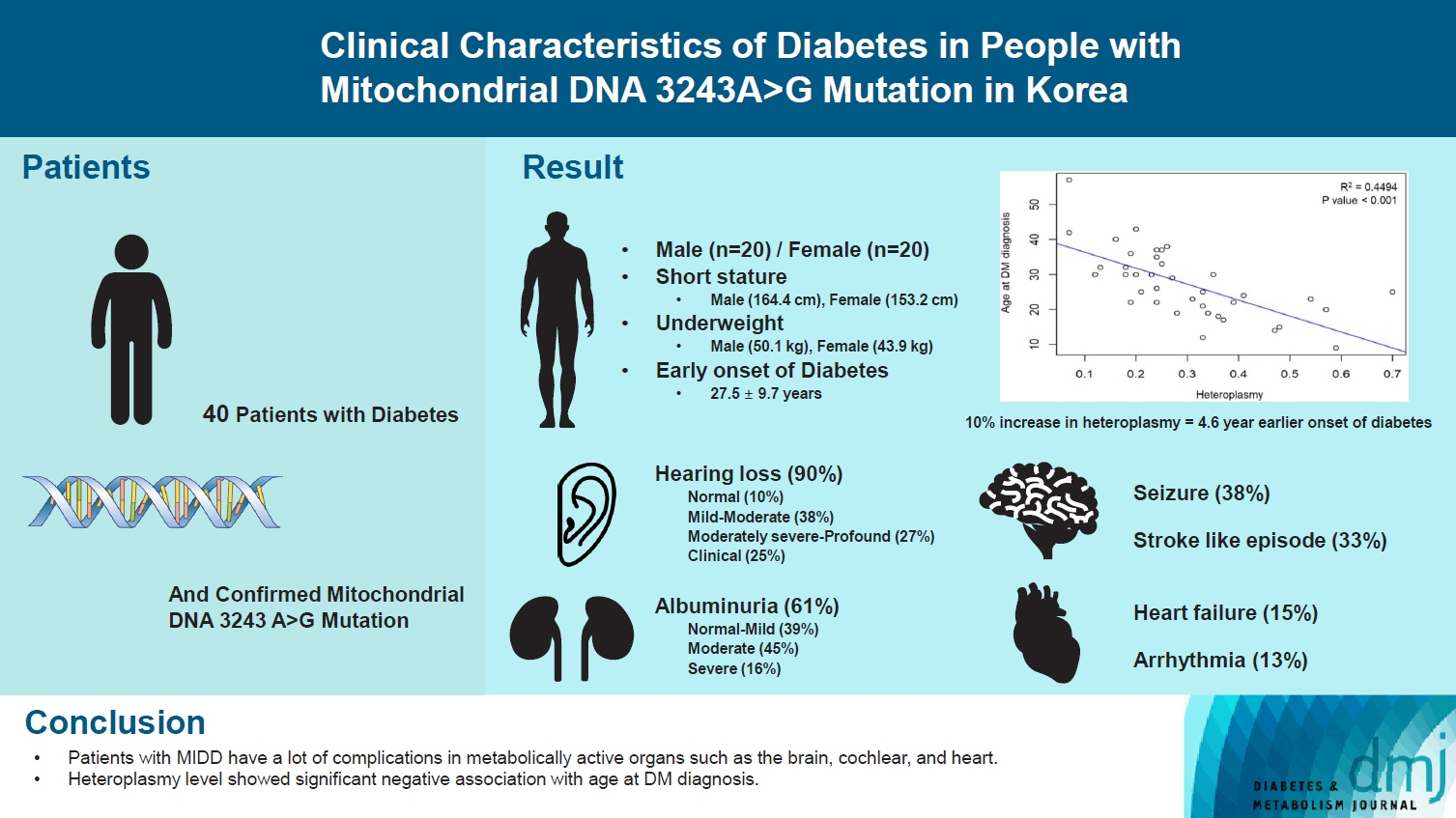Diabetes Metab J.
2024 May;48(3):482-486. 10.4093/dmj.2023.0078.
Clinical Characteristics of Diabetes in People with Mitochondrial DNA 3243A>G Mutation in Korea
- Affiliations
-
- 1Division of Endocrinology and Metabolism, Department of Internal Medicine, Seoul National University College of Medicine, Seoul, Korea
- 2Department of Internal Medicine, Green Hospital, Seoul, Korea
- 3Department of Laboratory Medicine, Seoul National University College of Medicine, Seoul, Korea
- 4Department of Pediatrics, Seoul National University College of Medicine, Seoul, Korea
- KMID: 2555779
- DOI: http://doi.org/10.4093/dmj.2023.0078
Abstract
- Maternally inherited diabetes and deafness (MIDD) is a rare mitochondrial disorder primarily resulting from m.3243A>G mutation. The clinical characteristics of MIDD exhibit significant heterogeneity. Our study aims to delineate these characteristics and determine the potential correlation with m.3243A>G heteroplasmy levels. This retrospective, descriptive study encompassed patients with confirmed m.3243A>G mutation and diabetes mellitus at Seoul National University Hospital. Our cohort comprises 40 patients with MIDD, with a mean age at study enrollment of 33.3±12.9 years and an average % of heteroplasmy of 30.0%± 14.6% in the peripheral blood. The most prevalent comorbidity was hearing loss (90%), followed by albuminuria (61%), seizure (38%), and stroke (33%). We observed a significant negative correlation between % of heteroplasmy and age at diabetes diagnosis. These clinical features can aid in the suspicion of MIDD and further consideration of genetic testing for m.3243A>G mutation.
Keyword
Figure
Cited by 2 articles
-
MIDD Patients Should Not Be Confused with MELAS Patients, Even Though Both Carry the m.3243A>G Variant
Josef Finsterer, Sounira Mehri
Diabetes Metab J. 2024;48(4):816-817. doi: 10.4093/dmj.2024.0065.Clinical Characteristics of Diabetes in People with Mitochondrial DNA 3243A>G Mutation in Korea (
Diabetes Metab J 2024;48:482-6)
Eun Hoo Rho, Soo Heon Kwak
Diabetes Metab J. 2024;48(4):818-819. doi: 10.4093/dmj.2024.0154.
Reference
-
1. Laloi-Michelin M, Meas T, Ambonville C, Bellanne-Chantelot C, Beaufils S, Massin P, et al. The clinical variability of maternally inherited diabetes and deafness is associated with the degree of heteroplasmy in blood leukocytes. J Clin Endocrinol Metab. 2009; 94:3025–30.
Article2. Murphy R, Turnbull DM, Walker M, Hattersley AT. Clinical features, diagnosis and management of maternally inherited diabetes and deafness (MIDD) associated with the 3243A>G mitochondrial point mutation. Diabet Med. 2008; 25:383–99.
Article3. de Laat P, Koene S, van den Heuvel LP, Rodenburg RJ, Janssen MC, Smeitink JA. Clinical features and heteroplasmy in blood, urine and saliva in 34 Dutch families carrying the m.3243A > G mutation. J Inherit Metab Dis. 2012; 35:1059–69.
Article4. Chae HW, Na JH, Kim HS, Lee YM. Mitochondrial diabetes and mitochondrial DNA mutation load in MELAS syndrome. Eur J Endocrinol. 2020; 183:505–12.
Article5. Yang M, Xu L, Xu C, Cui Y, Jiang S, Dong J, et al. The mutations and clinical variability in maternally inherited diabetes and deafness: an analysis of 161 patients. Front Endocrinol (Lausanne). 2021; 12:728043.
Article6. Cree LM, Samuels DC, Chinnery PF. The inheritance of pathogenic mitochondrial DNA mutations. Biochim Biophys Acta. 2009; 1792:1097–102.
Article7. Frederiksen AL, Andersen PH, Kyvik KO, Jeppesen TD, Vissing J, Schwartz M. Tissue specific distribution of the 3243A->G mtDNA mutation. J Med Genet. 2006; 43:671–7.
Article8. Grady JP, Pickett SJ, Ng YS, Alston CL, Blakely EL, Hardy SA, et al. mtDNA heteroplasmy level and copy number indicate disease burden in m.3243A>G mitochondrial disease. EMBO Mol Med. 2018; 10:e8262.
Article9. Park SS, Jang SS, Ahn CH, Kim JH, Jung HS, Cho YM, et al. Identifying pathogenic variants of monogenic diabetes using targeted panel sequencing in an East Asian population. J Clin Endocrinol Metab. 2019; 104:4188–98.
Article10. Suzuki S. Diabetes mellitus with mitochondrial gene mutations in Japan. Ann N Y Acad Sci. 2004; 1011:185–92.
Article11. Katagiri H, Asano T, Ishihara H, Inukai K, Anai M, Yamanouchi T, et al. Mitochondrial diabetes mellitus: prevalence and clinical characterization of diabetes due to mitochondrial tRNA(Leu (UUR)) gene mutation in Japanese patients. Diabetologia. 1994; 37:504–10.
Article
- Full Text Links
- Actions
-
Cited
- CITED
-
- Close
- Share
- Similar articles
-
- Clinical Characteristics of Diabetes in People with Mitochondrial DNA 3243A>G Mutation in Korea (Diabetes Metab J 2024;48:482-6)
- Mitochondrial DNA A3243G mutation in noise-induced sensorineural hearing loss
- Maternally Inherited Diabetes and Deafness Presenting with Memory Impairment and Gait Disturbance
- Sensorinerual Hearing Loss Harboring a Mitochondrial DNA tRNA(Leu(UUR)) Point Mutation
- The Usefulness of Muscle Biopsy in Initial Diagnostic Evaluation of Mitochondrial Encephalomyopathy, Lactic Acidosis, and Stroke-Like Episodes



